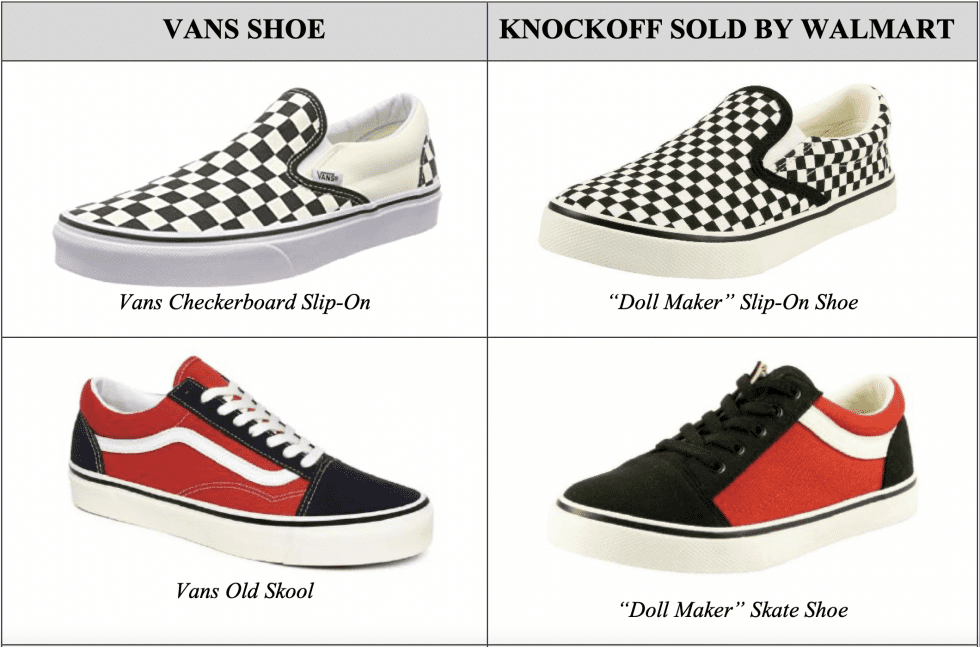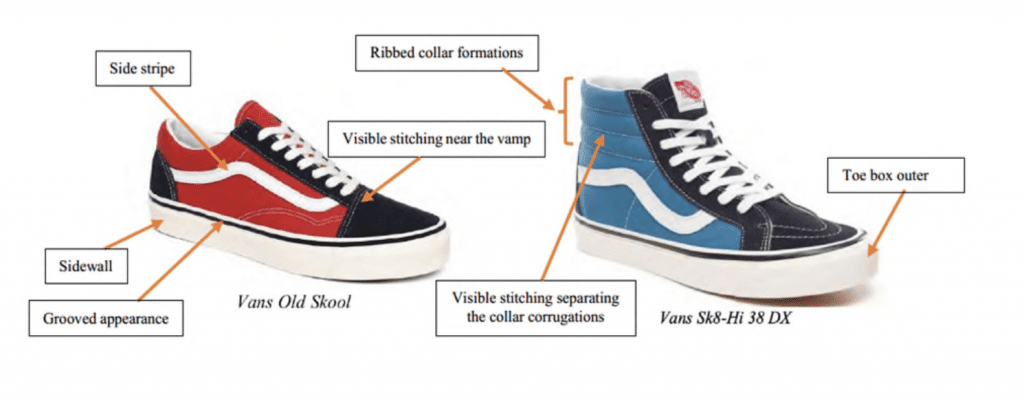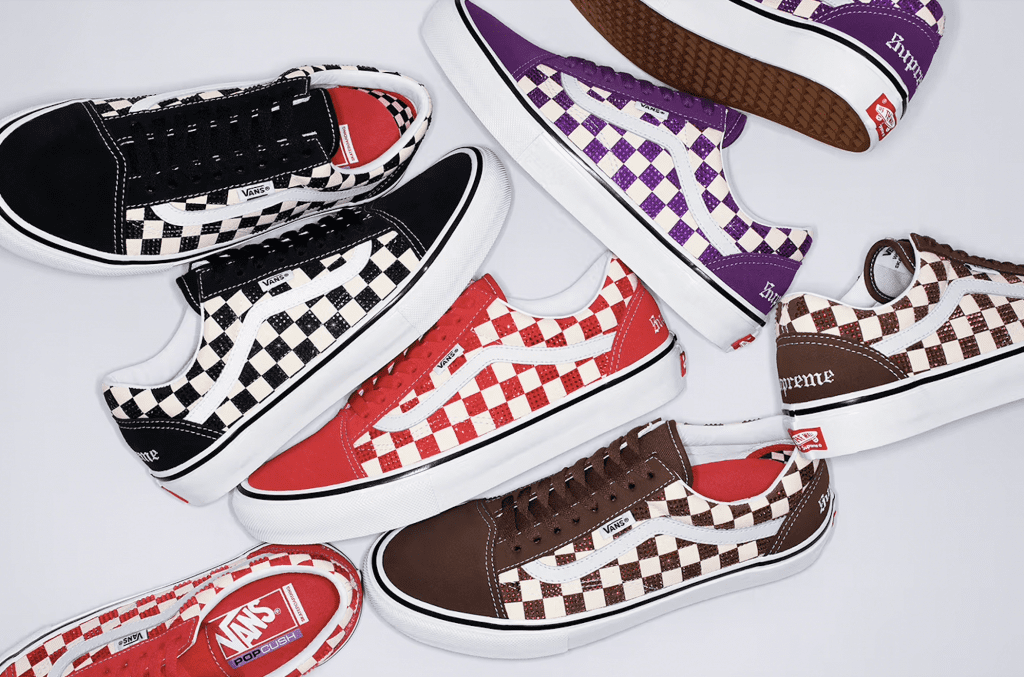Vans has failed to set out protectable trademarks for some of its best-selling sneaker styles, a footwear manufacturer tied to Walmart asserts in latest round of an ongoing lawsuit. In a newly-filed motion for summary judgment, ACIInternational (“ACI”), which is named as a defendant alongside Walmart in a lawsuit filed by Vans, claims that the Old Skool sneaker-maker has failed to meet its burden to prove a protectable trade dress – and thus, cannot prove its trademark infringement and unfair competition causes of action – since the alleged trade dresses it does claim contain “vague and indefinite language defeating the requirement that [such marks] be ‘distinctive.’” Beyond that, ACI alleges that Vans also fails to meet its burden to prove that its “alleged trade dresses are non-functional.”
Setting the stage in the motion for summary judgment that it filed with a federal court in California on August 10, ACI asserts that it “has been in business since the 1950s, has been supplying footwear to Walmart since the 1980s, and never supplies shoes to Walmart until it has obtained opinions of independent trademark counsel that the shoes do not infringe any intellectual property of anyone.” Despite such alleged due diligence, ACI landed on the receiving end of a Vans-initiated trademark suit, which centers in large part on the VF Corporation-owned company’s unregistered “Old Skool” and “SK8-HI” trade dresses.

– Vans alleges that its “Old Skool Trade Dress” consists “of a distinctive combination of source-identifying elements, including: (1) the Vans Side Stripe Mark on the shoe upper; (2) a rubberized sidewall with a consistent height around the perimeter of the shoe; (3) the uppermost portion of the sidewall having a three-tiered or grooved appearance; (4) a textured toe box outer around the front of the sidewall; (5) visible stitching, including where the eyestay meets the vamp; and (6) the placement and proportion of these elements in relation to one another.”
– Vans alleges that its “SK8-HI Trade Dress” consists “of a distinctive combination of source-identifying elements, including: (1) the Vans Side Stripe Mark on the shoe upper; (2) a rubberized sidewall with a consistent height around the perimeter of the shoe; (3) the uppermost portion of the sidewall having a three-tiered or grooved appearance; (4) a textured toe box outer around the front of the sidewall; (5) a ribbed collar formation that encircles the uppermost part of the shoe; (6) visible stitching, including separating the individual ankle collar corrugations; and (7) the placement and proportion of these elements in relation to one another.”
“Vague, Indefinite Descriptions”
In furtherance of its summary judgment bid, ACI argues that Vans’ claims fail because the four trade dresses that it asserts are “plagued by vague, indefinite descriptions … that do not provide ACI with sufficient notice of the scope of Vans’ claims.” In particular, ACI takes issue with Vans’ use of the term “including” when describing the “visible stitching” that is part of both its Old Skool and SK8-HI trade dresses on that basis that it is “especially indefinite in light of Vans’ refusal to define or even specify what constitutes ‘visible stitching’ – a fundamentally vague and subjective term that varies based on what is ‘visible’ to each person.” (Certainly, stitching is either visible or it isn’t, and maybe not as “subjective” as ACI makes it out to be.)
“Vans’ use of the terms ‘visible stitching’ and ‘including’ are non-distinctive as a matter of law and, thus, cannot support a protectable trade dress,” per ACI, which further argues that Vans “reinforces the non-distinctiveness underlying its alleged trade dresses when it alleges that those trade dresses consist of ‘the placement and proportion of [the other listed] elements in relation to one another.’” ACI states that Vans’ reliance on a phrase as broad and elusive as “‘the placement and proportion of … elements in relation to one another’ – whatever that may mean – does not give ACI adequate notice of the alleged trade dresses at issue, much less ‘articulate [any] trade dress with particularity.’”
TLDR: Citing the Ninth Circuit, ACI states that a plaintiff must “do more than just point to the ‘overall look,’ it must ‘articulate the specific elements which comprise its distinct dress.’” Vans’ “cataloguing” of various elements – including non-distinctive elements such as ‘visible stitching’ – before baldly claiming trade dress protection over the ‘the placement and proportion of [those] elements in relation to one another’ does not pass muster,” according to ACI. (For a similar fight over the sufficiency-of-the-trade-dress-description that is underway before the U.S. District Court for the Southern district of New York, see Nike v. BAPE.)
Failure to Prove Non-Functionality
Meanwhile, Vans “has not come close to satisfying its burden of proving non-functionality of its alleged trade dresses by a preponderance of the evidence,” ACI argues, and as such, it cannot prove its trademark infringement or its unfair competition claims. Specifically, ACI asserts that Vans fails to meet its burden to prove that its alleged trade dresses are non-functional, which it cannot do since “the combination of the elements in its Old Skool and SK8-HI trade dress have sufficient utilitarian and/or aesthetic functionality as to bar Vans from trade dress protection.”
Pointing to a number of allegedly functional elements embodied in the Old Skool and SK8-HI sneakers, ACI claims that, among other things, “without the side stripe, the side quarter of the Vans shoe would tend to sag or fold over onto itself and result in a more sloppy look,” “the consistent height of the rubberized sidewall creates a cost effective and repeatable manufacturing process as to vary the foxing tape from a straight line would require hand work that would be prohibitively costly,” and “the textured toe box outer serves the function of reducing the impact or appearance of scrapes or scuff marks on shoes, and in the case of skateboarders, provides additional and better grip for performing tricks.”

In short: “Each element in Vans’ Old Skool and SK8-HI trade dress, the combination of the elements, including their placement and proportion to one another, serve either a utilitarian function by being essential to all vulcanized footwear or to attaching, affixing, or stitching materials together or serving an aesthetic purpose wholly distinct and independent of any source identifying function,” according to ACI.
While Vans “will likely claim that it is the combination of all of the elements in [its] Old Skool and SK8-HI [sneakers] that make up each respective trade dress,” ACI asserts that courts “have consistently held that, as a matter of law, a product’s ‘overall appearance’ is functional, and thus unprotectable, where the whole product is ‘nothing other than the assemblage of functional parts,’ and ‘even the arrangement and combination’ of those parts is designed to make the product more functional.”
With the foregoing in mind, ACI states that Vans cannot prove that it infringed on any of its alleged trade dresses, and accordingly, it also cannot prove that ACI engaged in any “unfair competition.”
Vans first filed the lawsuit against Walmart and ACI in November 2021, accusing the retail titan and its supplier of infringing its valuable trademarks by “flood[ing] the market with cheap, low-quality, and confusingly similar shoes that harm Vans’ goodwill and reputation.”
The case is Vans, Inc. et al, v. Walmart, Inc., et al, 8:21-cv-01876 (C.D.Cal.)











